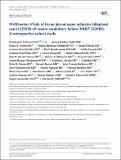MUlticenter STudy of tissue plasminogen activator (alteplase) use in COVID‐19 severe respiratory failure (MUST COVID): A retrospective cohort study
Author(s)
Yaffe, Michael; Barrett, Christopher
DownloadPublished version (1.070Mb)
Publisher with Creative Commons License
Publisher with Creative Commons License
Creative Commons Attribution
Terms of use
Metadata
Show full item recordAbstract
BACKGROUND: Few therapies exist to treat severe COVID-19 respiratory failure once it develops. Given known diffuse pulmonary microthrombi on autopsy studies of COVID-19 patients, we hypothesized that tissue plasminogen activator (tPA) may improve pulmonary function in COVID-19 respiratory failure. METHODS: A multicenter, retrospective, observational study of patients with confirmed COVID-19 and severe respiratory failure who received systemic tPA (alteplase) was performed. Seventy-nine adults from seven medical centers were included in the final analysis after institutional review boards' approval; 23 were excluded from analysis because tPA was administered for pulmonary macroembolism or deep venous thrombosis. The primary outcome was improvement in the PaO2/FiO2 ratio from baseline to 48 h after tPA. Linear mixed modeling was used for analysis. RESULTS: tPA was associated with significant PaO2/FiO2 improvement at 48 h (estimated paired difference = 23.1 ± 6.7), which was sustained at 72 h (interaction term p < 0.00). tPA administration was also associated with improved National Early Warning Score 2 scores at 24, 48, and 72 h after receiving tPA (interaction term p = 0.00). D-dimer was significantly elevated immediately after tPA, consistent with lysis of formed clot. Patients with declining respiratory status preceding tPA administration had more marked improvement in PaO2/FiO2 ratios than those who had poor but stable (not declining) respiratory status. There was one intracranial hemorrhage, which occurred within 24 h following tPA administration. CONCLUSIONS: These data suggest tPA is associated with significant improvement in pulmonary function in severe COVID-19 respiratory failure, especially in patients whose pulmonary function is in decline, and has an acceptable safety profile in this patient population.
Date issued
2022Department
Massachusetts Institute of Technology. Department of Biology; Massachusetts Institute of Technology. Department of Biological EngineeringJournal
Research and Practice in Thrombosis and Haemostasis
Publisher
Wiley
Citation
Yaffe, Michael and Barrett, Christopher. 2022. "MUlticenter STudy of tissue plasminogen activator (alteplase) use in COVID‐19 severe respiratory failure (MUST COVID): A retrospective cohort study." Research and Practice in Thrombosis and Haemostasis, 6 (2).
Version: Final published version